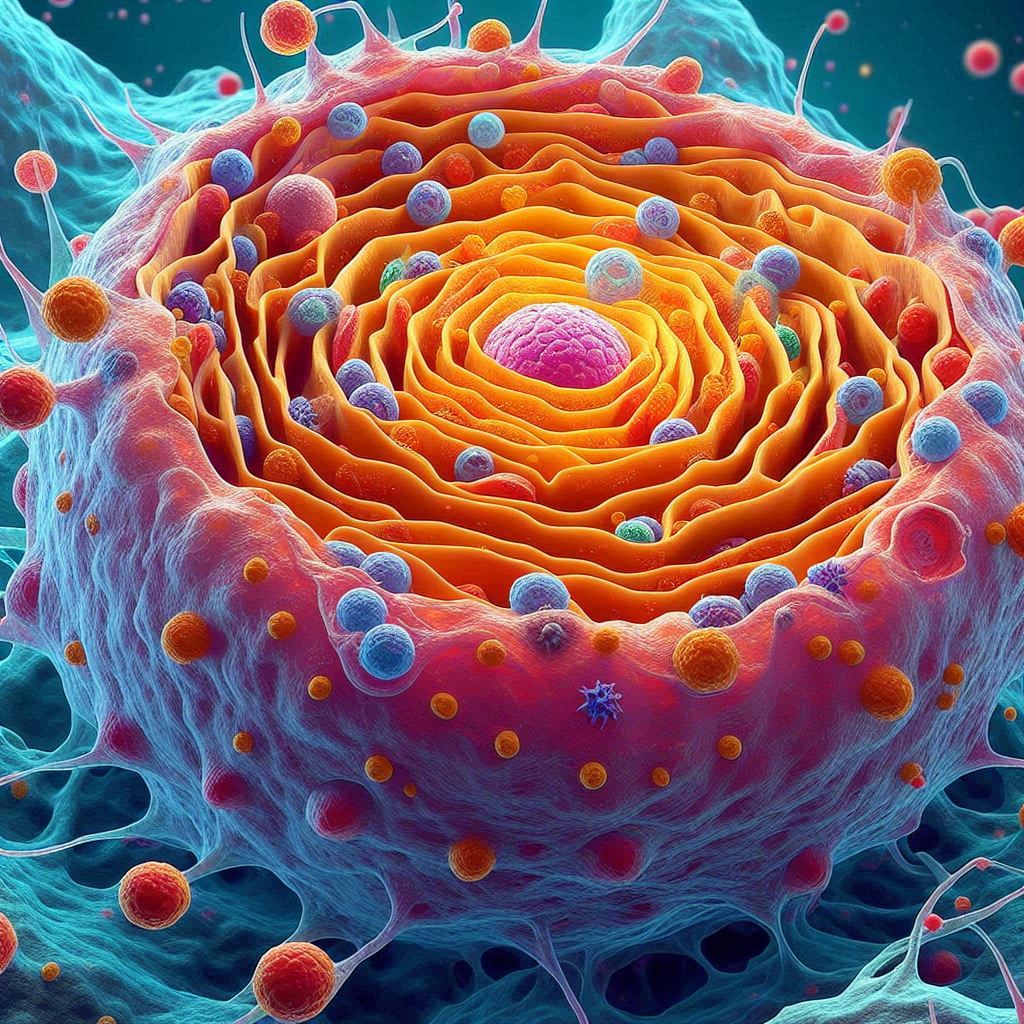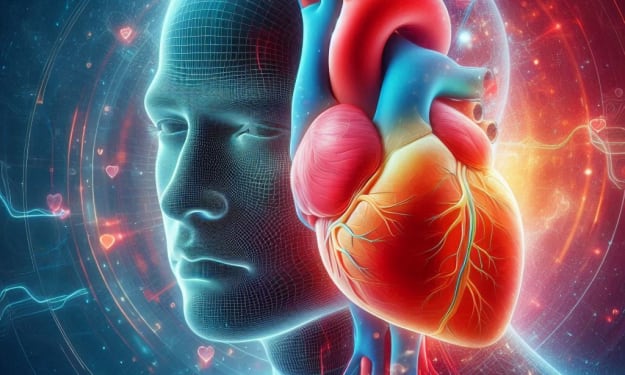Beyond the Visible: A Journey into the Colorful World of the ER
Discover the unseen architect shaping your health, one protein at a time.

The Unseen Architect of Life: Unveiling the Endoplasmic Reticulum's Vital Role in Your Cells
Imagine a hidden factory within every cell of your body, tirelessly constructing proteins and molecules essential for your health. This intricate network, invisible to the naked eye, is the endoplasmic reticulum (ER), a dynamic organelle playing a central role in various cellular functions. Understanding its structure and functions empowers us to appreciate its impact on our well-being and the potential implications for future advancements in medicine.
A Cellular Maze: Unveiling the Structure of the ER
The ER is a network of interconnected membranes, resembling flattened sacs called cisternae. These membranes divide the ER into two distinct functional regions: rough endoplasmic reticulum (RER) and smooth endoplasmic reticulum (SER).
The Rough Endoplasmic Reticulum: A Protein Production Powerhouse
The RER, studded with ribosomes, resembles a bustling factory floor. Ribosomes are cellular machines responsible for protein synthesis. Proteins synthesized on the RER are destined for various purposes, including:
Export: Proteins meant to be secreted from the cell, like insulin (a hormone regulating blood sugar) and antibodies (proteins crucial for fighting infections).
Cell Membrane Integration: Proteins that become part of the cell membrane, acting as receptors for hormones or neurotransmitters (chemicals that transmit signals between neurons).
Internal Vesicle Components: Proteins destined for membrane-bound compartments within the cell, such as enzymes for lysosomes (cellular "recycling centers").
Folding and Finishing Touches: The Art of Protein Modification
Here's a fascinating detail: the RER not only constructs these proteins but also modifies them through a series of "finishing touches." These modifications ensure proper folding – the process by which proteins achieve their three-dimensional structure – and often involve the attachment of sugars or phosphate groups. Imagine a protein as a complex origami figure – the RER folds and modifies it, ensuring it functions correctly.
Chaperones: The Helping Hands of Protein Folding
Within the crowded environment of the RER, protein folding can be a delicate process. Here's where chaperone molecules come in. These "cellular helpers" bind to newly synthesized proteins, assisting them in folding into their correct shapes. Think of chaperones as quality control inspectors at the protein factory, ensuring only properly folded proteins move on to their final destinations.
The Smooth Endoplasmic Reticulum: A Multifaceted Player
The SER, devoid of ribosomes, focuses on functions beyond protein synthesis. Here are some of its key roles:
- Lipid and Steroid Production: The SER is a hub for synthesizing essential lipids like phospholipids, crucial for cell membrane structure, and steroids, including cholesterol and the sex hormones testosterone and estrogen.
- Detoxification Powerhouse: The SER contains enzymes like cytochrome P450, which play a vital role in breaking down and detoxifying various substances, including medications, toxins, and even environmental pollutants. This function is particularly important in the liver, where the SER is abundant. Consider the SER as the cell's "detoxification center," tirelessly working to keep us safe from harmful substances.
- Calcium Control in Muscle Cells: In specialized muscle cells, the SER, known as the sarcoplasmic reticulum (SR), acts as a calcium storage compartment. Calcium ions are essential for muscle contraction and relaxation. The SR precisely regulates calcium release and reuptake, orchestrating the delicate dance of muscle movement. Imagine the SR as a precisely controlled reservoir, releasing calcium at the right moment to trigger muscle contraction.
The Stress Response: When the Factory Overloads
The ER maintains a delicate balance between protein synthesis and folding. However, various factors like nutrient deficiencies, toxins, or certain diseases can disrupt this balance, leading to the accumulation of misfolded proteins within the ER. This triggers a cellular stress response known as the unfolded protein response (UPR).
The UPR is a protective mechanism. It attempts to restore ER function by slowing down protein synthesis, increasing the production of chaperone molecules, and enhancing protein degradation pathways. However, prolonged activation of the UPR can lead to cell death. Understanding the UPR is crucial, as it's a potential target for future therapies aimed at restoring ER function in various diseases.
When the Factory Falters: Clinical Implications of ER Dysfunction
Disruptions in ER function can lead to various health problems. Here are some examples:
- Neurodegenerative Diseases: Research suggests a potential link between chronic ER stress and the development of neurodegenerative diseases like Alzheimer's and Parkinson's. These diseases are characterized by the accumulation of misfolded proteins in the brain. Understanding the role of the ER in these conditions could pave the way for new treatment strategies.
- Metabolic Disorders: Conditions like cystic fibrosis and non-alcoholic fatty liver disease (NAFLD) are associated with ER dysfunction. Cystic fibrosis results from a mutation in a protein that normally helps the movement of mucus within the lungs. When this protein is misfolded due to ER dysfunction, it can clog airways and lead to breathing difficulties. In NAFLD, excessive fat accumulation in the liver disrupts ER function, potentially leading to inflammation and liver damage.
The Future of the ER: Research Frontiers
The ER remains an area of active research, with scientists exploring its role in various diseases. Some exciting avenues include:
- Therapeutic Strategies for ER Stress: Developing treatments to alleviate chronic ER stress holds promise for managing neurodegenerative diseases, metabolic disorders, and other conditions associated with protein misfolding. Researchers are exploring various approaches, including drugs that enhance chaperone function or promote the degradation of misfolded proteins.
- Personalized Medicine: Understanding the genetic variations that impact ER function could pave the way for personalized medicine approaches. By analyzing an individual's genetic makeup, doctors could predict their susceptibility to ER stress-related diseases and tailor treatments accordingly.
- Dietary and Lifestyle Modifications: Emerging research suggests that certain dietary and lifestyle modifications may positively impact ER function. For example, a diet rich in antioxidants and low in saturated fats can help reduce ER stress. Additionally, regular exercise can enhance protein folding efficiency within the ER.
The Takeaway: The Unsung Hero Within
The endoplasmic reticulum, though hidden within our cells, plays a vital role in maintaining our health. By understanding its structure and functions, we gain a deeper appreciation for the intricate machinery that keeps us alive and functioning. As research continues to unravel the ER's secrets, we can expect exciting advancements in medicine that target ER dysfunction for improved health outcomes. Furthermore, by adopting healthy lifestyle practices, we can support optimal ER function and contribute to our overall well-being.
About the Creator
suren arju
Hi there! I'm Suren, your startup guide. Entrepreneur, writer, dreamer - I share insights, tips & stories to fuel your startup journey. Ready to explore, learn & win together? Join me & let's redefine how we launch, learn & leap!
Enjoyed the story? Support the Creator.
Subscribe for free to receive all their stories in your feed. You could also pledge your support or give them a one-off tip, letting them know you appreciate their work.





Comments
There are no comments for this story
Be the first to respond and start the conversation.